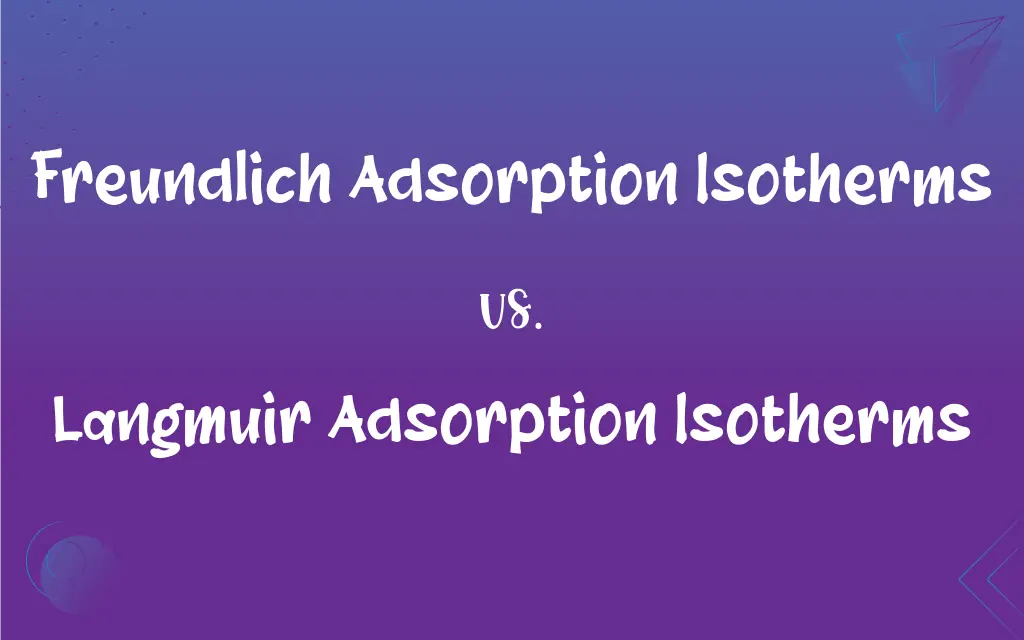Freundlich Adsorption Isotherms vs. Langmuir Adsorption Isotherms: What's the Difference?
By Janet White || Published on February 20, 2024
Freundlich adsorption isotherms describe non-ideal, reversible adsorption not limited to monolayer formation. Langmuir adsorption isotherms describe monolayer adsorption with a finite number of identical sites.

Key Differences
Freundlich adsorption isotherms represent adsorption on heterogeneous surfaces and suggest a multilayer adsorption. In contrast, Langmuir adsorption isotherms describe adsorption on homogeneous surfaces with uniform sites, leading to monolayer coverage.
The Freundlich model implies that adsorption capacity increases indefinitely with concentration. Langmuir isotherms assume a saturation point beyond which no further adsorption occurs.
Freundlich isotherms are empirical, based on observations and experiments. Langmuir isotherms are theoretical, based on assumptions of ideal surfaces and processes.
In Freundlich adsorption, the rate of adsorption diminishes as the adsorbate concentration increases. Langmuir adsorption is characterized by uniform adsorption energies and no interaction between adsorbed molecules.
Freundlich isotherms are applicable over a wide range of concentrations. Langmuir isotherms work best at low to intermediate concentrations.
ADVERTISEMENT
Comparison Chart
Surface Heterogeneity
Assumes heterogeneous surface
Assumes homogeneous surface
Layer Formation
Multilayer adsorption possible
Only monolayer adsorption
Adsorption Capacity
Increases indefinitely with concentration
Reaches saturation at a finite concentration
Theoretical or Empirical
Empirical, based on observations
Theoretical, based on ideal assumptions
Concentration Range Applicability
Effective over a wide range of concentrations
Best at low to intermediate concentrations
ADVERTISEMENT
Freundlich Adsorption Isotherms and Langmuir Adsorption Isotherms Definitions
Freundlich Adsorption Isotherms
Indicates multilayer adsorption without a saturation point.
In water treatment, the Freundlich isotherm helps predict how pollutants adhere to filters.
Langmuir Adsorption Isotherms
A theoretical model based on ideal surface assumptions.
Researchers applied the Langmuir isotherm to predict adsorption in drug delivery systems.
Freundlich Adsorption Isotherms
Suggests decreasing adsorption intensity with increasing concentration.
Freundlich isotherms were used to study the variable adsorption of heavy metals in soil.
Langmuir Adsorption Isotherms
Describe monolayer adsorption on surfaces with uniform adsorption sites.
The Langmuir isotherm modeled how molecules form a single layer on a catalyst surface.
Freundlich Adsorption Isotherms
Describe adsorption on heterogeneous surfaces with varying affinities.
The Freundlich isotherm was used to model the adsorption of dye on activated carbon.
Langmuir Adsorption Isotherms
Assumes a finite number of identical adsorption sites.
Using the Langmuir isotherm, scientists quantified the adsorption capacity of enzymes.
Freundlich Adsorption Isotherms
Characterized by a non-linear relationship between concentration and adsorption.
The Freundlich isotherm accurately represented the adsorption behavior of gases on charcoal.
Langmuir Adsorption Isotherms
Characterized by a saturation point for adsorption capacity.
The Langmuir isotherm explained the plateau in adsorption observed at high pressures.
Freundlich Adsorption Isotherms
An empirical model derived from experimental data.
Researchers used the Freundlich isotherm to explain the adsorption of pesticides on clay.
Langmuir Adsorption Isotherms
Assumes no interaction between adsorbed molecules.
Langmuir isotherms helped in understanding the adsorption of gases on metal surfaces in fuel cells.
FAQs
What does a Langmuir adsorption isotherm represent?
A theoretical model for monolayer adsorption on homogeneous surfaces.
Can Freundlich isotherms predict multilayer adsorption?
Yes, they suggest the possibility of multilayer adsorption.
Are Freundlich isotherms based on theoretical or empirical data?
They are empirical, derived from experimental observations.
Do Langmuir isotherms have a saturation point?
Yes, they indicate a finite adsorption capacity.
Is the Langmuir isotherm more suitable for low concentrations?
It's most effective at low to intermediate concentrations.
What is a Freundlich adsorption isotherm?
An empirical model describing adsorption on heterogeneous surfaces.
What type of adsorption does the Freundlich isotherm indicate?
It indicates non-ideal, multilayer adsorption.
How does the Langmuir isotherm view adsorption energy?
It views adsorption energy as uniform across the surface.
Can Freundlich isotherms be applied to a wide range of concentrations?
Yes, they are effective over a broad concentration range.
Do Freundlich isotherms assume a heterogeneous or homogeneous surface?
They assume a heterogeneous surface.
What assumption do Langmuir isotherms make about adsorption sites?
They assume a finite number of identical adsorption sites.
Do Freundlich isotherms allow for varying adsorption affinities?
Yes, they account for varying affinities on the surface.
Can Freundlich isotherms model adsorption at high pressures?
They are less accurate at very high pressures.
How do Langmuir isotherms treat surface heterogeneity?
They assume the surface is homogeneous.
What is a limitation of the Langmuir isotherm?
It may not accurately predict adsorption on real, non-ideal surfaces.
Is the Freundlich isotherm nonlinear?
Yes, it shows a nonlinear relationship between concentration and adsorption.
Are Freundlich isotherms useful in environmental studies?
Yes, especially for adsorption of pollutants.
Do Langmuir isotherms consider interactions between adsorbed molecules?
No, they assume no interaction between adsorbed molecules.
Are Langmuir isotherms applicable in industrial processes?
Yes, particularly in catalysis and surface chemistry.
Can Langmuir isotherms be used for gases and liquids?
Yes, they are applicable to both gases and liquids.
About Author
Written by
Janet WhiteJanet White has been an esteemed writer and blogger for Difference Wiki. Holding a Master's degree in Science and Medical Journalism from the prestigious Boston University, she has consistently demonstrated her expertise and passion for her field. When she's not immersed in her work, Janet relishes her time exercising, delving into a good book, and cherishing moments with friends and family.







































































